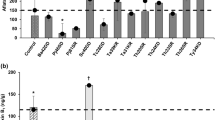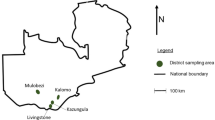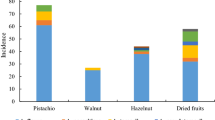Abstract
Invasion of crops with Aspergillus flavus may result in contamination of food and feed with carcinogenic mycotoxins such as aflatoxins (AF) and cyclopiazonic acid (CPA). In the present study, distribution and toxigenicity of Aspergillus flavus and A. parasiticus in soils of five peanut fields located in Guilan province, Northern Iran was investigated. From a total of 30 soil samples, 53 strains were isolated which all of them were finally identified as A. flavus by a combination of colony morphology, microscopic criteria and mycotoxin profiles. Chromatographic analysis of fungal cultures on yeast extract sucrose broth by tip culture method showed that 45 of the 53 A. flavus isolates (84.9 %) were able to produce either CPA or AFB1, while eight of the isolates (15.1 %) were non-toxigenic. The amounts of CPA and AFB1 produced by the isolates were reported in the range of 18.2–403.8 μg/g and 53.3–7446.3 μg/g fungal dry weights, respectively. Chemotype classification of A. flavus isolates based on the ability for producing mycotoxins and sclerotia showed that 43.4 % were producers of CPA, AFB1 and sclerotia (group I), 13.2 % of CPA and AFB1 (group II), 9.4 % of AFB1 and sclerotia (group III), 13.2 % of AFB1 (group IV), 5.7 % of CPA and sclerotia (group V) and 15.1 % were non-toxigenic with no sclerotia (group VI). No strain was found as producer of only CPA or sclerotia. These results indicate different populations of mycotoxigenic A. flavus strains enable to produce hazardous amounts of AFB1 and CPA are present in peanuts field soils which can be quite important regard to their potential to contaminate peanuts as a main crop consumed in human and animal nutrition.


Similar content being viewed by others
References
Bennett JW, Klich M (2003) Mycotoxins. Clin Microbiol Rev 16:497–516
Varga J, Frisvad JC, Samson RA (2011) Two new aflatoxin producing species and an overview of Aspergillus section Flavi. Stud Mycol 69:57–80
Chang PK, Horn BW, Dorner JW (2009) Clustered genes involved in cyclopiazonic acid production are next to the aflatoxin biosynthesis gene cluster in Aspergillus flavus. Fungal Genet Biol 46:176–182
Purchase IF (1971) The acute toxicity of the mycotoxin cyclopiazonic acid to rats. Toxicol Appl Pharmacol 18:114–123
Norred WP, Porter JK, Dorner JW, Cole RJ (1988) Occurrence of the mycotoxin cyclopiazonic acid in meat after oral administration to chickens. J Agric Food Chem 36:113–116
Riley RT, Goeger DE, Yoo H, Showker JL (1992) Comparison of three tetramic acids and their ability to alter membrane function in cultured skeletal muscle cells and sarcoplasmic reticulum vesicles. Toxicol Appl Pharmacol 114:261–267
Lansden JA, Davidson JI (1983) Occurrence of cyclopiazonic acid in peanuts. Appl Environ Microbiol 45:766–769
Martins ML, Martins HM (1999) Natural and in vitro coproduction of cyclopiazonic acid and aflatoxins. J Food Prot 62:292–294
Vaamonde G, Patriarca A, Fernandez Pinto V, Comerio R, Degrossi C (2003) Variability of aflatoxin and cyclopiazonic acid production by Aspergillus section Flavi from different substrates in Argentina. Int J Food Microbiol 88:79–84
Astoreca AL, Dalsero AM, Fernandez Pinto V, Vaamonde G (2011) A survey on distribution and toxigenicity of Aspergillus section Flavi in poultry feeds. Int J Food Microbiol 146:38–43
Dorner JW, Cole RJ, Lomax LG, Gosser HS, Diener UL (1983) Cyclopiazonic acid production by Aspergillus flavus and its effects on broiler chickens. Appl Environ Microbiol 46:698–703
Urano T, Trucksess MW, Beaver RW, Wilson DM, Dorner JW, Dowell FE (1992) Co-occurrence of cyclopiazonic acid and aflatoxins in corn and peanuts. J AOAC Int 75:838–841
Horn BW, Dorner JW (1999) Regional differences in production of aflatoxin B1 and cyclopiazonic acid by soil isolates of Aspergillus flavus along a transect within the United States. Appl Environ Microbiol 65:1444–1449
Donner M, Atehnkeng J, Sikora RA, Bandyopadhyay R, Cotty PJ (2009) Distribution of Aspergillus section Flavi in soils of maize fields in three agroecological zones of Nigeria. Soil Biol Biochem 41:37–44
Pitt JI, Hocking AD, Glenn DR (1983) An improved medium for the detection of Aspergillus flavus and A. parasiticus. J Appl Bacteriol 54:109–114
Razzaghi-Abyaneh M, Shams-Ghahfarokhi M, Allameh A, Kazeroon-Shiri A, Ranjbar-Bahadori S, Mirzahoseini H, Rezaee MB (2006) A survey on distribution of Aspergillus section Flavi in corn field soils in Iran: population patterns based on aflatoxins, cyclopiazonic acid and sclerotia production. Mycopathologia 161:183–192
Klich MA, Pitt JI (1988) A laboratory guide to the common Aspergillus species and their teleomorphs. Commonwealth Scientific and Industrial Research Organization, Division of Food Processing, Sydney
Yabe K, Nakamura H, Ando Y, Terakudo N, Nakajima H, Hamasaki T (1988) Isolation and characterization of Aspergillus parasiticus mutants with impaired aflatoxin production by novel tip culture method. Appl Environ Microbiol 54:2096–2100
Dorner JW (1983) Production of cyclopiazonic acid by Aspergillus tamarii Kita. Appl Environ Microbiol 46:1435–1437
Razzaghi-Abyaneh M, Yoshinari T, Shams-Ghahfarokhi M, Rezaee MB, Nagasawa H, Sakuda S (2007) Dillapiol and apiol as specific inhibitors for the biosynthesis of aflatoxin G1 in Aspergillus parasiticus. Biosci Biotechnol Biochem 71:2329–2332
Tran-Dinh N, Kennedy I, Bui T, Carter D (2009) Survey of Vietnamese peanuts, corn and soil for the presence of Aspergillus flavus and Aspergillus parasiticus. Mycopathologia 168:257–268
Lomax LG, Cole RJ, Dorner JW (1984) The toxicity of cyclopiazonic acid in weaned pigs. Vet Pathol 21:418–424
Rao LB, Husain A (1985) Presence of cyclopiazonic acid in kodo millet (Paspalum scrobiculatum) causing ‘kodua poisoning’ in man and its production by associated fungi. Mycopathologia 89:177–180
Antony M, Shukla Y, Janardhanan KK (2003) Potential risk of acute hepatotoxicity of kodo poisoning due to exposure to cyclopiazonic acid. J Ethnopharmacol 87:211–214
Giorni P, Magan N, Pietri A, Bertuzzi T, Battilani P (2007) Studies on Aspergillus section Flavi isolated from maize in northern Italy. Int J Food Microbiol 113:330–338
Manabe M, Tsuruta O, Tanaka K, Matsuura S (1976) Distribution of aflatoxin-producing fungi in soil in Japan. Trans Mycol Soc Jpn 17:436–444
Lillehoj EB, McMillian WW, Guthrie WD, Barry D (1980) Aflatoxin-producing fungi in preharvest corn: inoculums source in insects and soils. J Environ Qual 9:691–694
Horn BW, Greene RL, Dorner JW (1995) Effect of corn and peanut cultivation on soil populations of Aspergillus flavus and A. parasiticus in southwestern Georgia. Appl Environ Microbiol 61:2472–2475
Barros G, Torres A, Palacio G, Chulze S (2003) Aspergillus species from section Flavi isolated from soil at planting and harvest time in peanut-growing regions of Argentina. J Sci Food Agric 83:1303–1307
Barros G, Torres A, Chulze S (2005) Aspergillus flavus population isolated from soil of Argentina’s peanut-growing region. Sclerotia production and toxigenic profile. J Sci Food Agric 85:2349–2353
Sultan Y, Magan N (2010) Mycotoxigenic fungi in peanuts from different geographic regions of Egypt. Mycotoxin Res 26:133–140
Atayde DD, Reis TA, Godoy IJ, Zorzete P, Reis GM, Corrêa B (2012) Mycobiota and aflatoxins in a peanut variety grown in different regions in the state of São Paulo, Brazil. Crop Prot 33:7–12
Nesci A, Montemarani A, Etcheverry M (2011) Assessment of mycoflora and infestation of insects, vector of Aspergillus section Flavi, in stored peanut from Argentina. Mycotoxin Res 27:5–12
Rodrigues P, Venancio A, Kozakiewicz Z, Lima N (2008) A polyphasic approach to the identification of aflatoxigenic and non-aflatoxigenic strains of Aspergillus section Flavi isolated from Portuguese almonds. Int J Food Microbiol 129:187–193
Willetts HJ, Bullock S (1992) Developmental biology of sclerotia. Mycol Res 96:801–816
Horn BW, Greene R, Sobolev VS, Dorner JW, Powell JH, Layton RC (1996) Association of morphology and mycotoxin production with vegetative compatibility groups in A. flavus, A. parasiticus, and A. tamarii. Mycologia 88:574–587
Cotty PJ, Bayman P, Egel DS, Elis KS (1994) Agriculture, aflatoxins and Aspergillus. In: Powell KA, Renwick A, Peberdy JF (eds) The genus Aspergillus: from taxonomy and genetics to industrial applications. Plenum Press, New York, pp 1–27
Acknowledgments
This study was supported financially by a grant from Research Deputy of Faculty of Medical Sciences at Tarbiat Modares University. The authors wish to thank Mrs. Razeghi and Ms. Jamali for their helpful assistance.
Author information
Authors and Affiliations
Corresponding author
Rights and permissions
About this article
Cite this article
Amani, S., Shams-Ghahfarokhi, M., Banasaz, M. et al. Mycotoxin-Producing Ability and Chemotype Diversity of Aspergillus Section Flavi from Soils of Peanut-Growing Regions in Iran. Indian J Microbiol 52, 551–556 (2012). https://doi.org/10.1007/s12088-012-0275-x
Received:
Accepted:
Published:
Issue Date:
DOI: https://doi.org/10.1007/s12088-012-0275-x




